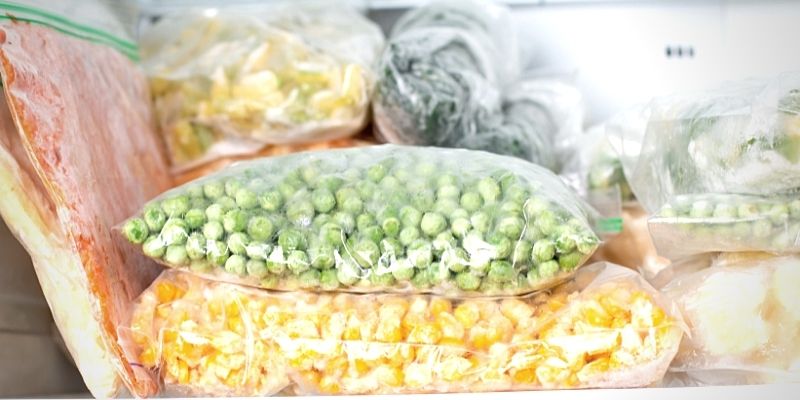With healthy habits top of mind, the question now becomes how to eat healthy meals without breaking the bank and how to ensure all of our newly purchased product doesn’t go to waste on our good intentions. Inevitably, the solution always turns to healthy meal planning.
But in this case, it’s not traditional meal planning. It’s the Wonder Woman meets Suze Orman’s version of meal planning.
The average American family spends $2,200 annually on food that is thrown out, Food that is tossed, wasted, never consumed. It doesn’t seem like a lot to throw out that weekly bag of lettuce or the avocado that now feels like a ball of mush or that bunch of bananas that are completely brown or even that container of yogurt that we never got around to. But every toss into the trash adds up $180/month wasted on uneaten food.
Before we know it, we have wasted an estimated $180 per month on food that we didn’t eat.
In fact, American’s throw out 25% of their food, most of which is fruits and vegetables that weren’t used in time.

But much of that waste (and expense) can be avoided by meal planning. Meal planning ensures that you’re not spending money on food that inevitably will get thrown away.
Here’s the Suze Orman part. If you took that $180/month savings you would gain by not purchasing foods that ultimately get thrown away, and put it into a savings account, you would have $22,000 at the end of 10 years.
That’s HUGE!
Tips For Healthy Meal Planning That Helps Reduce Food Waste
Make a healthy meal planning list and stick to it
Make a list of what you plan to eat for breakfast, lunch, dinner, and snacks. Stick to it. No impulse buys. Only buy what you need this week.
Don’t stock your pantry for Armageddon
If you grew up shopping with your grandparents, then you can likely recall the pantries filled with canned good after canned good. Most of which were never consumed and ended up being tossed because they lost their shelf life. The truth is that we only need a few staples in our pantry.
Buy Bulk Produce Healthy Meals With Caution
Yes, bulk purchases are great for non-perishables and can ultimately save you money, but a lot of food waste (and money waste) comes from buying produce in bulk. That 2-package container of spinach seems like a good deal, but if I don’t have time to consume that much, then I’m losing money on what I throw out. The exception would be when produce is in season and you’re planning to freeze or can the surplus.
Buy frozen fruits and vegetables
If you routinely throw out produce, then switch to frozen fruits and vegetables. Frozen fruits and vegetables are packaged at their peak when nutrients are at their highest, so this is a great alternative to fresh produce. Just be sure you’re buying frozen foods without any additives like sauces, sugar, or salt (no cheesy frozen broccoli allowed). Therefore, this is a good idea for healthy meal planning.

Freeze produce that’s getting a little too ripe
If your banana is looking too ripe, just throw it in the freezer. The next time you make a smoothie or want to make a healthy version of ice cream, just throw your frozen banana in the blender and you have a tasty treat.
Compost
Throw your produce scraps in a compost pile. It’s a terrible feeling to throw out food, but putting scraps in a compost pile helps to ease that feeling of guilt. The finished product is an amazing soil rich in nutrients and perfect for a summer of organic container gardening.
Purchase A Healthy Meals With A Plan
That eggplant is on sale and looks like a great idea for the week. But guess what? It’s still in your refrigerator two weeks later waiting on your plan and wilting a bit each day. Stick with your grocery list and meal plan and you’ll soon avoid these “maybe I’ll make something with that….” impulse buys.
Meal Planning is the #1 way to ensure your family eats healthy and stays on budget each week. If you’re looking for a tool to help you accomplish all of this, give the Healthy Kids Inc. meal planner a try.
Healthy Kids Inc. is an online meal planning tool that helps you plan your healthy meals and grocery list. It will keep your grocery trip planned and within budget, every time. Not only does it have over 300 recipes to use to fill your meal plan calendar (along with a Professional Chef’s “How To” video for each), but it also populates your shopping list in minutes, even suggesting when to purchase organic produce based on the Dirty Dozen.
It will transform the way your family plans, preps, and cooks each week. Check out their video and then give it a try for even a week to see what a difference it makes. Say hello to stress-free, healthy meals. No skills required!
Conclusion
Meal Planning is the #1 way to ensure your family eats healthy and stays on budget each week.
Moreover, healthy meal planning has a big impact to reduce huge food waste. Thus, this will help save money for you and your family in many ways.
Buying and then not consuming your product will give you guilt putting them into the trash, especially that nowadays, food gets easily spoiled.
By learning healthy meal planning and food preservation techniques, you can save your food keep your food.
Find out how to set family goals by learning out tips on our Creating Goals With Your Family in Mind page.
My name is Andrea Thompson and I’m a home based freelance writer. I’m 23 years old, married to my best friend, and mother to a wonderfully independent and opinionated 3 year old girl and step-mother to a sweet seven year old boy. I live in a tiny, little town in Kentucky, where I spend my free time fishing with my kids.
Writing has always been my passion, which I followed through high school, and for a while in college. Life happened, and once I discovered we were pregnant, I switched directions; opting for the healthcare industry because of the stability.
Finally, years later, I was in a place where I could leave the day job that never truly made me happy, and pursue my dreams. I’ve built, and am still building, my writing career from scratch. But, I’m passionate and I’m good at what I do. And, in the end, I can prove to my daughter that she can do anything she wants with this life.





